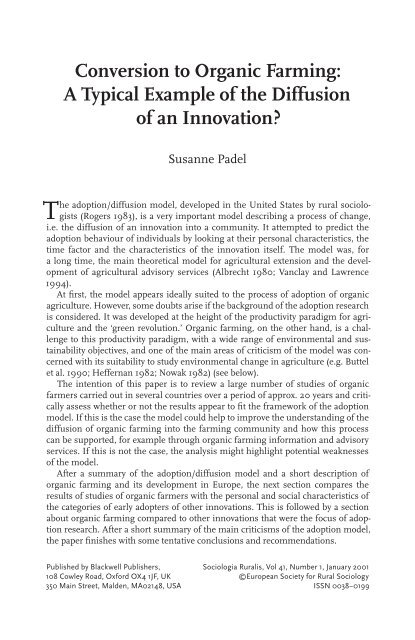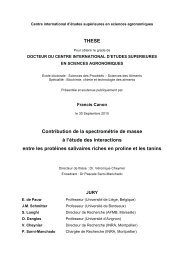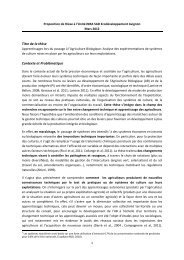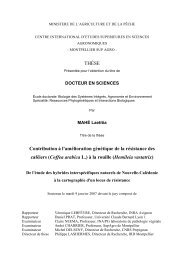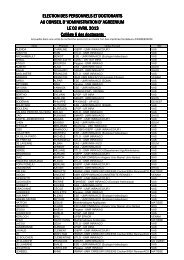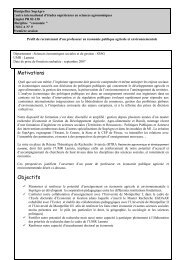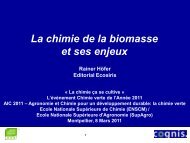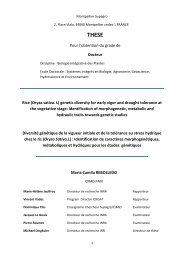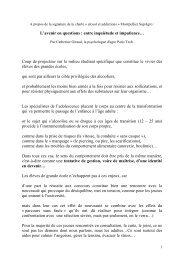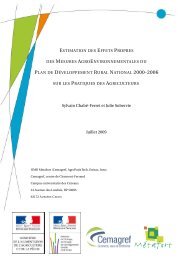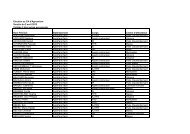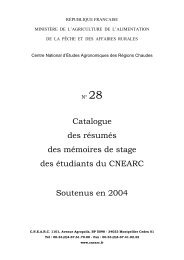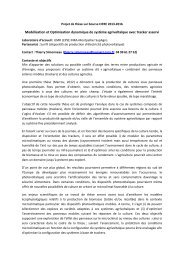Conversion to Organic Farming: A Typical Example of the Diffusion ...
Conversion to Organic Farming: A Typical Example of the Diffusion ...
Conversion to Organic Farming: A Typical Example of the Diffusion ...
Create successful ePaper yourself
Turn your PDF publications into a flip-book with our unique Google optimized e-Paper software.
Figure 4(1985-1999)605040Average farm size <strong>Conversion</strong> <strong>of</strong> organic <strong>to</strong> <strong>Organic</strong> farms in<strong>Farming</strong><strong>the</strong> EU, Germany and Denmark 45haDKDE3020EU10085 86 87 88 89 90 91 92 93 94 95 96 97 98YearestFigure 3: Average farm size <strong>of</strong> organic farms in <strong>the</strong> eu, Germany and Denmark, 1985-1999Sources: Own calculations based on Lampkin (2000). Arrows show <strong>the</strong> point where <strong>the</strong> farmsize becomes larger than <strong>the</strong> conventional average size for holdings for 1995Arrows show <strong>the</strong> point where <strong>the</strong> farm size becomes larger than <strong>the</strong> conventional average size for holdingsfor 1995However, several older German studies and one study from <strong>the</strong> usa found organicSource: farms Own calculations <strong>to</strong> be larger based than conventional on Lampkin holdings (2000) (Boeckenh<strong>of</strong>f et al. 1986; Dabbert1990b; Wernick and Lockeretz 1977). In a recent review <strong>of</strong> comparative data onorganic farming across <strong>the</strong> eu, Offermann and Nieberg (2000) found <strong>the</strong> averagesize <strong>of</strong> organic farms <strong>to</strong> be larger than comparable conventional ones. The developmen<strong>to</strong>f <strong>the</strong> average size <strong>of</strong> organic producers in <strong>the</strong> eu, and Germany and Denmarkas two contrasting examples, is shown in Figure 3. The figure shows a trend<strong>to</strong>wards bigger holdings across <strong>the</strong> whole eu and in Germany. Average organicholding size decreased in Denmark between 1985 and 1990, but has increased eversince. Across <strong>the</strong> eu <strong>the</strong> average size <strong>of</strong> organic holdings has been larger than forconventional farms (based on average holding size calculated on <strong>the</strong> basis <strong>of</strong> <strong>the</strong>1993 census) since <strong>the</strong> late 1980s, in Germany this point was reached in <strong>the</strong> early1990s and in Denmark in middle <strong>of</strong> <strong>the</strong> 1990s. Overall this leads <strong>to</strong> <strong>the</strong> generalhypo<strong>the</strong>sis that <strong>the</strong> average organic farm size increases during <strong>the</strong> process <strong>of</strong> diffusion,but it is possible that this is related <strong>to</strong> changes in <strong>the</strong> structure <strong>of</strong> <strong>the</strong> agriculturalindustry in general and that a point <strong>of</strong> stabilization <strong>of</strong> farm size may occur.Fur<strong>the</strong>r research across a wider range <strong>of</strong> countries would be needed <strong>to</strong> confirm this.Motivation <strong>to</strong> convert <strong>to</strong> organic farmingAdoption research led <strong>to</strong> <strong>the</strong> general conclusion that earlier adopters were orientatedmore <strong>to</strong>wards commercial than subsistence farming (Rogers 1983). Pampeland van Es (1997) and Taylor (1978) found early adopters <strong>of</strong> soil conservation notso pr<strong>of</strong>it oriented, which led some researchers <strong>to</strong> seek new ways <strong>of</strong> understanding<strong>the</strong> uptake <strong>of</strong> soil conservation outside <strong>the</strong> adoption framework (Buttel et al. 1990),99est
46 Padelwhilst o<strong>the</strong>rs suggested modifications and refinements (e.g. Taylor and Miller 1987;Nowak 1982, see also <strong>the</strong> discussion <strong>of</strong> <strong>the</strong> limitations <strong>of</strong> <strong>the</strong> adoption model below).Although <strong>the</strong>re is little direct research about <strong>the</strong> goals <strong>of</strong> organic farmers in general,<strong>the</strong>ir motives for conversion have been studied frequently and appear <strong>to</strong> havechanged over time. However, direct comparison <strong>of</strong> <strong>the</strong> studies is difficult as <strong>the</strong> categories<strong>of</strong> answers vary from study <strong>to</strong> study. Commonly reference <strong>to</strong> farm relatedand personal goals is made (see Table 1).Table 1: Motivations <strong>to</strong> convert <strong>to</strong> organic production<strong>Farming</strong> related motivesHusbandry and technical reasonsanimal health problemsoil fertility and erosion problemsPersonal motivesPersonal healthown and family health problemsergonomic reasonsFinancial motivessolve existing financial problemssecure future <strong>of</strong> <strong>the</strong> farmcost savingpremium marketingGeneral concernsstewardshipfood qualityconservationenvironmentalrural developmentThe farming-related motivations can be split in<strong>to</strong> husbandry and financial reasons.In earlier studies <strong>the</strong> husbandry related concerns appear more frequent, whereasin later studies financial reasons are more dominant. Several earlier studies foundbetween 30 and 75 per cent <strong>of</strong> <strong>the</strong>ir sample mentioning problems with conventionalfarming, e.g. soil erosion or deteriorating animal health as an important reasonfor <strong>the</strong> conversion (Fischer 1982; Vine and Bateman 1981; Vogtmann et al. 1993;Wernick and Lockeretz 1977; Wynen 1990). In two recent studies from Switzerlandand <strong>the</strong> usa, husbandry is also mentioned, but <strong>the</strong> farmer mention <strong>the</strong> pr<strong>of</strong>essionalchallenge in going organic ra<strong>the</strong>r than problems with conventional systems(Duram 1999; Maurer 1997).Financial reasons include attempts <strong>to</strong> solve existing problems as well as <strong>the</strong>desire <strong>to</strong> secure <strong>the</strong> long-term existence <strong>of</strong> <strong>the</strong> farm. They cover cost saving throughorganic production as well as premium price marketing (Brigh<strong>to</strong>n et al. 1988;Conacher and Conacher 1982; Fisher 1989; Lockeretz and Madden 1987; MacRaeet al. 1990; Svensson 1991; Vogtmann et al. 1993; Wynen 1990). Although <strong>the</strong> aim<strong>to</strong> secure <strong>the</strong> future <strong>of</strong> <strong>the</strong> farm has been frequently mentioned in earlier studies,financial motives such as <strong>the</strong> incentive <strong>to</strong> sell for a premium and <strong>the</strong> view <strong>to</strong> seeorganic farming as a means <strong>to</strong> cut costs are more dominant in later studies. Thismay be related <strong>to</strong> <strong>the</strong> generally more difficult financial situation <strong>of</strong> farming. Padel(2000) argued that at least among British organic dairy producers a qualitative shift<strong>to</strong>wards more financial motivations <strong>to</strong>ok place long before <strong>the</strong> introduction <strong>of</strong> conversionaid payments in 1994, possibly in 1992/1993 when organic premiums onmilk became more widely available in <strong>the</strong> uk. However, a fairly recent survey <strong>of</strong>237 organic and conventional horticulture producers in <strong>the</strong> uk (Bur<strong>to</strong>n et al. 1997b)found non-economic aspects widely present in <strong>the</strong> decision <strong>to</strong> go organic, whichmay reflect <strong>the</strong> importance <strong>of</strong> lifestyle related goals for organic growers from urbanbackgrounds (see above).
<strong>Conversion</strong> <strong>to</strong> <strong>Organic</strong> <strong>Farming</strong>47Personal reasons can be divided in<strong>to</strong> personal health experiences and more generalconcerns. Personal health reasons and ergonomic concerns (relating <strong>to</strong> <strong>the</strong>health risk from applying chemicals) are widely mentioned throughout (Dettmer1986; Fischer 1982; Rantzau et al. 1990; Svensson 1991; Vine and Bateman 1981;Vogtmann et al. 1993). With general concerns <strong>the</strong>re appears <strong>to</strong> have been a shiftfrom religious and philosophical concerns in <strong>the</strong> earlier studies <strong>to</strong> <strong>the</strong> greater prevalence<strong>of</strong> environmental and political ones in later studies (Ashmole 1993; Brigh<strong>to</strong>net al. 1988; Buchdahl 1982; Bur<strong>to</strong>n et al. 1997, Conacher and Conacher 1982; Dettmer1986; Fischer 1982; Halpin et al. 1984; Rantzau et al. 1990; Svensson 1991;Vine and Bateman 1981; Vogtmann et al. 1993; Wernick and Lockeretz 1977).In a relatively new study from Switzerland, farmers with low and moderateinput use were more likely <strong>to</strong> consider conversion, and new converters aimed <strong>to</strong>stay actively involved in general agricultural networks (Maurer 1997). This wasalso expressed in a new study <strong>of</strong> American organic producers who resented <strong>the</strong>attitude <strong>of</strong> what <strong>the</strong> organic farmers called ‘radical environmentalists’ as hampering<strong>the</strong> establishment <strong>of</strong> good relationships with conventional producers (Duram1999).In all studies reviewed, <strong>the</strong> organic farmers expressed a wide variety <strong>of</strong> motivesfor <strong>the</strong> conversion and on <strong>the</strong> basis <strong>of</strong> this it can be hypo<strong>the</strong>sized that <strong>the</strong> goals<strong>of</strong> organic farmers consist <strong>of</strong> a mixture <strong>of</strong> non-financial and financial ones, andfor agriculture traditional as well as o<strong>the</strong>r objectives (Zerger 1995). It appears thatearlier organic farmers were more strongly motivated by husbandry problems andreligious concerns, whereas ‘newer’ organic farmers are concerned about <strong>the</strong> environment,have economic reasons and increasingly see organic farming as a pr<strong>of</strong>essionalchallenge.Comparing early organic farmers with typical innova<strong>to</strong>rsMost <strong>of</strong> <strong>the</strong> studies <strong>of</strong> organic farmers reviewed here were undertaken whenorganic farming was (and in some countries still appears <strong>to</strong> be) at a very earlystage <strong>of</strong> diffusion. The results show that <strong>the</strong> farmers studied clearly share somecharacteristics with typical innova<strong>to</strong>rs, such as a good education and a wide socialnetwork. In some countries a relatively high proportion <strong>of</strong> early organic farmersand growers from urban backgrounds was found and woman seem <strong>to</strong> play a moreactive role although empirical evidence is very limited. Average farm size wasfound <strong>to</strong> be smaller in most countries than for conventional farms, which mayreflect <strong>the</strong> high proportion <strong>of</strong> lifestyle and self-sufficiency oriented farmers in <strong>the</strong>organic group. Across Europe a trend <strong>to</strong>wards increases in average organic holdingsize can be observed. Aspects <strong>of</strong> lifestyle are also reflected in <strong>the</strong> more personalmotivations <strong>to</strong> convert <strong>to</strong> organic farming. <strong>Organic</strong> farmers generally do nothave purely financial motives for <strong>the</strong>ir conversion, although <strong>the</strong>se are more frequentlymentioned in later studies. In this respect <strong>the</strong>y differ from farmers adoptingo<strong>the</strong>r commercial innovations early, but show similarities with innova<strong>to</strong>rs andearly adopters <strong>of</strong> o<strong>the</strong>r environmental innovations (e.g. Taylor and Miller 1978;Vanclay and Lawrence 1994).Much <strong>of</strong> <strong>the</strong> research <strong>of</strong> organic farmers reviewed here was carried out <strong>to</strong> showsimilarities between organic and o<strong>the</strong>r farmers, so it could be proven that organic
48 Padelfarming had a wider relevance than just for a small group. However, it was frequentlyfound that <strong>the</strong> organic farmers studied were different from <strong>the</strong> averagefarmer. They were better educated, had less farming experience, had in some studiessmaller farms and placed less emphasis on pr<strong>of</strong>it maximization. The discussion<strong>of</strong> conversion studies in <strong>the</strong> adoption/diffusion framework throws an interestingnew light on <strong>the</strong>se results, as <strong>the</strong> difference can be interpreted as that between earlierand later adopters.The results <strong>of</strong> o<strong>the</strong>r surveys <strong>of</strong> organic farmers converting since <strong>the</strong> late 1980s,such as <strong>the</strong> better social integration <strong>of</strong> more recent adopters, an increasing averagefarm size and <strong>the</strong> increased importance <strong>of</strong> financial motivations, suggest that insome countries <strong>the</strong> stage <strong>of</strong> early adoption may have been reached. On <strong>the</strong> basis<strong>of</strong> <strong>the</strong> model it could be expected that <strong>the</strong> farmers adopting in this stage, <strong>the</strong> earlyadopters, would show again different personal characteristics. Fisher (1989) tried<strong>to</strong> establish a difference between earlier and later adopters <strong>of</strong> organic farming inNew Zealand, but did not succeed. Given <strong>the</strong> small numbers <strong>of</strong> organic farms inNew Zealand at <strong>the</strong> time <strong>of</strong> his study (a <strong>to</strong>tal <strong>of</strong> 200 certified farms (Crowder 1991))<strong>the</strong> lack <strong>of</strong> success is not surprising.A Norwegian sociological study found three different categories <strong>of</strong> organic farmersin Norway, labeled as: Anthroposophists, Ecosophists, and Reformists. The Anthroposophistswere influenced by biodynamic agriculture and Rudolf Steiner andshowed some similarities <strong>to</strong> <strong>the</strong> innova<strong>to</strong>rs <strong>of</strong> <strong>the</strong> adoption model, such as a verystrong commitment <strong>to</strong> <strong>the</strong>ir ideas. Farmers in <strong>the</strong> second cluster <strong>of</strong> Ecosophistswere motivated by green ideas. They were part <strong>of</strong> <strong>the</strong> environmental and back <strong>to</strong><strong>the</strong> land movement and Vartdal (1993) argued that <strong>the</strong>y showed some similarities<strong>to</strong> early adopters. In both categories a non-farming background was widespread.The Reformists were described as ‘normal’ farmers with a pragmatic approach <strong>to</strong>organic agriculture and were described as corresponding <strong>to</strong> <strong>the</strong> early majority in<strong>the</strong> adoption model (Vartdal 1993). This confirms <strong>the</strong> applicability <strong>of</strong> <strong>the</strong> model,although some <strong>of</strong> Vartdal’s results seem <strong>to</strong> suggest that Reformists might represent<strong>the</strong> early adopters category <strong>of</strong> agricultural opinion leaders, whereas <strong>the</strong> two o<strong>the</strong>rgroups would fall in<strong>to</strong> <strong>the</strong> category <strong>of</strong> innova<strong>to</strong>rs.This difference between <strong>the</strong> ‘early idealists’ and <strong>the</strong> later ‘pr<strong>of</strong>it oriented pragmatists’is heatedly debated in <strong>the</strong> organic movement in various countries. This conflictis also reflected in some studies <strong>of</strong> <strong>the</strong> organic farming movement. Vartdal(1993), for example, <strong>to</strong>ok <strong>the</strong> perspective <strong>of</strong> an interested conventional farmer,seeing <strong>the</strong> early organic farmers and <strong>the</strong>ir organizations as gatekeepers, who protected‘<strong>the</strong>ir’ innovation and <strong>the</strong>refore made it more difficult for conventional farmers<strong>to</strong> adopt. Gerber et al. (1996), on <strong>the</strong> o<strong>the</strong>r hand, positioned <strong>the</strong>mselves as par<strong>to</strong>f <strong>the</strong> ‘old’ organic movement in Germany and discussed any pressure <strong>to</strong> reduce<strong>the</strong> requirements in <strong>the</strong> standards as coming from <strong>the</strong> outside and claimed that <strong>the</strong>true organic movement had <strong>to</strong> protect its identity. Allowing a greater number <strong>of</strong>farmers <strong>to</strong> participate was seen as a threat <strong>to</strong> <strong>the</strong> principles. Tovey (1997) discusseda similar process in <strong>the</strong> Irish organic movement, which according <strong>to</strong> her consisted<strong>of</strong> many members that were not food producers. Again she emphasized <strong>the</strong> dangerthat with an increasing number <strong>of</strong> farmers and <strong>the</strong> need for larger organizations,such as <strong>the</strong> establishment <strong>of</strong> certification procedures, <strong>the</strong> organic movement maybe in danger <strong>of</strong> loosing its identity.
<strong>Conversion</strong> <strong>to</strong> <strong>Organic</strong> <strong>Farming</strong>49<strong>Organic</strong> farming compared with o<strong>the</strong>r innovations<strong>Organic</strong> farming differs in several respects from o<strong>the</strong>r innovations that have been<strong>the</strong> focus <strong>of</strong> adoption research. According <strong>to</strong> <strong>the</strong> adoption model an innovationhas <strong>to</strong> fulfill certain criteria <strong>to</strong> be easily adopted, such as having obvious and economicadvantages. Fur<strong>the</strong>rmore, an innovation should be simple and understandable,divisible as a practice, associated with low risk and compatible with <strong>the</strong> currentvalues and norms (Albrecht 1974; Buttel et al. 1990).Potential barriers <strong>to</strong> <strong>the</strong> adoption <strong>of</strong> organic farming were studied by Blobaum(1983) in <strong>the</strong> Midwestern United States when only very few conventional farmershad adopted organic methods, whereas <strong>the</strong>re was a substantial proportion <strong>of</strong>organic producers who considered <strong>the</strong>mselves always <strong>to</strong> have been organic.Blobaum presented <strong>the</strong> results <strong>of</strong> his survey using <strong>the</strong> terms <strong>of</strong> <strong>the</strong> adoption/diffusion model, and identified problems with access <strong>to</strong> information, access <strong>to</strong>markets, farm structure problems and <strong>the</strong> availability <strong>of</strong> necessary organic inputs,problems with landlords and banks, and technical problems. In a broader contex<strong>to</strong>f environmental innovations, Vanclay and Lawrence (1994) argued that for farmers<strong>the</strong> non-adoption <strong>of</strong> such practices may be a very rational choice, because<strong>of</strong> <strong>the</strong> characteristics <strong>of</strong> <strong>the</strong> innovations, such as <strong>the</strong> complexity and need for awhole system change, economic disadvantages (although that might not apply<strong>to</strong> all environmental changes), higher risk, conflicting information, indivisibilityand reduced flexibility in management decisions, and incompatibility with o<strong>the</strong>raspects <strong>of</strong> <strong>the</strong> farming system.The following section aims <strong>to</strong> explore whe<strong>the</strong>r organic farming as an innovationshows similar characteristics <strong>to</strong> o<strong>the</strong>r environmental innovations that may representpotential barriers <strong>to</strong> <strong>the</strong> conversion.Complexity and divisibility<strong>Organic</strong> farming is a complex system and <strong>the</strong> conversion <strong>to</strong> organic managementaffects <strong>the</strong> whole farming system, not only single enterprises. For example, <strong>the</strong>design <strong>of</strong> <strong>the</strong> crop rotation has an influence on forage production, fertility buildingand weed and pest control. The application <strong>of</strong> <strong>the</strong> adoption model <strong>to</strong> such a systemchange is unusual, since most adoption research has been carried out on <strong>the</strong> adoption<strong>of</strong> single techniques, like <strong>the</strong> use <strong>of</strong> hybrid seed corn in Iowa (Ryan and Gross1943). On <strong>the</strong> o<strong>the</strong>r hand, however, <strong>the</strong> decision <strong>to</strong> adopt reduced-input systemsdoes not seem <strong>to</strong> be more complicated than <strong>the</strong> decision <strong>to</strong> introduce irrigation on<strong>the</strong> farm (Lockeretz 1991).In adoption research it was fur<strong>the</strong>r discovered that farmers <strong>of</strong>ten experimen<strong>to</strong>n one field before <strong>the</strong>y introduce a new technology on <strong>the</strong> whole farm (Ryanand Gross 1943) and it was <strong>the</strong>refore concluded that innovations are more easilyadopted if <strong>the</strong> practice is highly divisible, i.e. can be tried on a small scale (Buttelet al. 1990). This also seems <strong>to</strong> be true for organic farming, which is tried atfirst ei<strong>the</strong>r in <strong>the</strong> vegetable garden (Fischer 1982; Fisher 1989), or by convertinga small section <strong>of</strong> <strong>the</strong> holding, so <strong>the</strong> farmer gain some experience with <strong>the</strong> newtechniques (Lampkin 1993). Conventional farmers have indicated <strong>the</strong>ir willingness<strong>to</strong> try organic farming on parts <strong>of</strong> <strong>the</strong>ir farm (Clarke 1991; NatWest 1992).
50 PadelTrying organic farming on parts <strong>of</strong> <strong>the</strong> farm can lead <strong>to</strong> difficulties because <strong>of</strong><strong>the</strong> complexity <strong>of</strong> <strong>the</strong> system. Just one field <strong>of</strong> <strong>the</strong> farm will not show <strong>the</strong> full potential<strong>of</strong> crop performance under organic management on that specific location, if n<strong>of</strong>ertility-building phase is incorporated. Therefore (and because <strong>of</strong> difficulties in carryingout inspection <strong>of</strong> such small units) most organic standards do not allow certification<strong>of</strong> individual fields, although under <strong>the</strong> eu regulation 2092/91 <strong>the</strong> certification<strong>of</strong> designated units <strong>of</strong> a larger farm is possible (ec 1991).However, in-depth interviews with eight British dairy farms Padel (2000) about<strong>the</strong>ir experiences with <strong>the</strong> conversion process showed that <strong>the</strong> majority had engagedin a range <strong>of</strong> related activities prior <strong>to</strong> or during <strong>the</strong> conversion phase, but before<strong>the</strong>y had made a final decision <strong>to</strong> convert <strong>the</strong> whole farm. These included experimentson a small block <strong>of</strong> land or with an organic vegetable enterprise, or usingcertain management techniques <strong>of</strong> organic systems prior <strong>to</strong> <strong>the</strong> conversion, suchas clover farming and homeopathy, and conversion planning. Farmers had also setparticular tests that <strong>the</strong> organic system had <strong>to</strong> pass, such as produce enough silagefor <strong>the</strong> winter. It appeared as if, despite all <strong>the</strong> information and support <strong>the</strong>y hadreceived, <strong>the</strong> farmers needed <strong>to</strong> develop experiences with <strong>the</strong> system on <strong>the</strong>ir ownfarm in order <strong>to</strong> gain <strong>the</strong> necessary confidence, before <strong>the</strong>y could make a final commitment.In several cases a staged conversion strategy where fields are convertedover several years had also been chosen for this reason, but allowed in addition <strong>the</strong>risk <strong>of</strong> conversion <strong>to</strong> be spread over several years.Economic advantages and disadvantagesAn innovation needs <strong>to</strong> have distinct advantages in order <strong>to</strong> be adopted. Advantagescould be financial in nature, but could also be in <strong>the</strong> area <strong>of</strong> soil fertility, animalhealth or human health, or general benefits <strong>to</strong> <strong>the</strong> environment. However, unlikesome o<strong>the</strong>r environmental innovations, organic farming does show some potentialfor improved financial performance <strong>of</strong> <strong>the</strong> farming system, although <strong>the</strong> conversionperiod as such might be costly and most studies <strong>of</strong> organic farmers appear <strong>to</strong>show a range ra<strong>the</strong>r than a single motive for <strong>the</strong> conversion.As far as <strong>the</strong> financial situation is concerned it is clear that <strong>the</strong> conversion period<strong>to</strong> organic farming itself is, in many cases, costly (Padel and Lampkin 1994a) anddoes not always lead <strong>to</strong> improved pr<strong>of</strong>its afterwards. In this sense, organic farmingdiffers from technological innovations that are commercially beneficial, but showssimilarities <strong>to</strong> o<strong>the</strong>r environmental innovations. The implications <strong>of</strong> this differencein terms <strong>of</strong> <strong>the</strong> objectives and goals <strong>of</strong> early adopters have already been mentioned.However, cases where organic farmers achieve a better financial return after <strong>the</strong>conversion period have also been identified (Padel and Lampkin 1994b). These arelikely <strong>to</strong> become more widespread with a better development <strong>of</strong> premium marketsfor organic products (Michelsen et al. 1999) and more widespread support throughgovernments in terms <strong>of</strong> conversion aid and organic farming subsidy programmes(see Lampkin et al. 1999, for details).For some farmers <strong>the</strong> conversion clearly has commercial benefits. On <strong>the</strong> basis<strong>of</strong> an extensive review <strong>of</strong> comparative economic studies <strong>of</strong> organic farming inEurope Offermann and Nieberg (2000) concluded that, on average, <strong>the</strong> decision<strong>to</strong> convert <strong>to</strong> organic farming had proven <strong>to</strong> be financially successful. However,
<strong>Conversion</strong> <strong>to</strong> <strong>Organic</strong> <strong>Farming</strong>51<strong>the</strong>y advised caution against generalizations, because several studies had identifiedlower pr<strong>of</strong>its and <strong>the</strong> differences between farms within a sample and between sampleswere considerable. Clear differences were also observed between farm types, withhigher relative pr<strong>of</strong>its for arable and dairy farms, and lower relative pr<strong>of</strong>its on horticulturaland beef and sheep producing farms (Fowler et al. 2000; Offermann andNieberg 2000). It is possible that <strong>the</strong> higher uptake <strong>of</strong> organic farming in some countriesand by some farm types might be related <strong>to</strong> a comparably better financial performance<strong>of</strong> such systems. However, <strong>the</strong> low uptake among arable producers in severalcountries despite a relatively better financial performance at least in model calculationsseems <strong>to</strong> contradict this (Padel et al. 2000). This may indicate that, in this context,<strong>the</strong> perception <strong>of</strong> relative pr<strong>of</strong>itability is more important than <strong>the</strong> actual values.Less clear appears <strong>to</strong> be <strong>the</strong> relationship between payment rates and uptake<strong>of</strong> conversion aid schemes. Padel et al. (1999) could not establish a clear relationshipbetween <strong>the</strong> level <strong>of</strong> payment rates under <strong>the</strong> organic farming options <strong>of</strong> <strong>the</strong>agri-environment programmes and <strong>the</strong> uptake <strong>of</strong> organic farming across Europe,although that <strong>to</strong> some extent uptake <strong>of</strong> <strong>the</strong> schemes was higher in <strong>the</strong> countrieswith better rates and more favourable conditions <strong>of</strong> <strong>the</strong> scheme.Low risk is regarded as one fac<strong>to</strong>r that characterizes innovations that are easilyadopted. The perceived risk <strong>of</strong> conversion <strong>to</strong> organic farming is mentioned as amajor obstacle in survey <strong>of</strong> conventional farmers (e.g. Chadwick and McGregor1991). On <strong>the</strong> basis <strong>of</strong> <strong>the</strong> available literature it is difficult <strong>to</strong> assess whe<strong>the</strong>r or notthis risk is perceived or real. Two contradic<strong>to</strong>ry opinions about risk associated withconversion <strong>to</strong> organic farming could be identified: Firstly, diversification going handin hand with conversion <strong>to</strong> organic farming is a strategy <strong>to</strong> reduce risk (MacRaeet al. 1989). Secondly, risk has been associated with conversion due <strong>to</strong> yield reductionsand mistakes leading <strong>to</strong> complete crop failure (Lampkin 1993). Fur<strong>the</strong>rmore,conversion is likely <strong>to</strong> be risky for particular farm types, for example intensive pigor poultry production or intensive fruit production, but in this context <strong>the</strong> perception<strong>of</strong> risk is almost more important than <strong>the</strong> real risk.The available evidence suggests that <strong>the</strong> economic advantages <strong>of</strong> conversion mayhis<strong>to</strong>rically have not been very clear, but may have increased over time, particularlyfor some farm types where markets are well established and in countries whereconversion aid payments and ongoing support <strong>of</strong> organic farming are available.However, for some farm types and in some countries conversion <strong>to</strong> organic farmingmay be associated with an economic penalty due <strong>to</strong> <strong>the</strong> costs <strong>of</strong> conversion anda potential loss <strong>of</strong> revenue <strong>the</strong>reafter. It is likely that <strong>the</strong> perception <strong>of</strong> lower pr<strong>of</strong>itand a high risk may be an important barrier <strong>to</strong> <strong>the</strong> conversion.<strong>Organic</strong> farming – an information based innovationRogers (1983) differentiated between <strong>the</strong> ‘hardware’ and ‘s<strong>of</strong>tware’ aspects <strong>of</strong> aninnovation. In ‘hardware’ he included <strong>the</strong> necessary technology, whereas ‘s<strong>of</strong>tware’referred <strong>to</strong> <strong>the</strong> information on how <strong>to</strong> use <strong>the</strong> technology, and evaluative informationabout its performance. The model considered <strong>the</strong> availability <strong>of</strong> informationabout <strong>the</strong> innovation as an important pre-condition for its wider diffusion and adoptionresearchers studied <strong>the</strong> information sources that farmers use in greater detail(Buttel et al. 1990; Lionberger 1960).
52 PadelUsing this classification organic farming would be a mainly ‘s<strong>of</strong>tware’ basedinnovation. <strong>Farming</strong> organically requires new management skills, like planning <strong>of</strong>a diverse rotation and techniques <strong>to</strong> manage biological resources <strong>to</strong> achieve regulation<strong>of</strong> pests and diseases as well as <strong>the</strong> use <strong>of</strong> mechanical or biological controlmethods for weeds, pests and diseases. The requirements for new inputs and newmachinery are limited, although <strong>the</strong>re may be some need for investment during<strong>the</strong> process <strong>of</strong> conversion, such as new weeding equipment or manure spreaders(Padel and Lampkin 1994a). Generally, low-input systems have been described asinformation intensive, but <strong>the</strong> information requirements <strong>of</strong> low-input farmers havenot been studied in detail (Lockeretz 1991).In this sense organic farming differs from o<strong>the</strong>r, technology based innovationsfor which <strong>the</strong> adoption model was developed. However, if availability <strong>of</strong> informationis regarded as important in <strong>the</strong> diffusion <strong>of</strong> technological innovations, it is likely <strong>to</strong>be even more important for a knowledge-based or ‘s<strong>of</strong>tware’ innovation. This hypo<strong>the</strong>sisis supported by <strong>the</strong> results <strong>of</strong> a survey <strong>of</strong> conventional farmers in <strong>the</strong> uk. Theywould like <strong>to</strong> see more independent information on <strong>the</strong> subject, especially in <strong>the</strong> area<strong>of</strong> financial performance (Chadwick and McGregor 1991). This gives a clear indicationthat evaluative information about <strong>the</strong> performance <strong>of</strong> organic farming, especiallyabout <strong>the</strong> financial implications, is needed in addition <strong>to</strong> technical knowledge.Evaluations <strong>of</strong> <strong>the</strong> information sources <strong>of</strong> organic farmers show <strong>the</strong> importance<strong>of</strong> o<strong>the</strong>r organic farmers (Bur<strong>to</strong>n et al. 1997b; Luley 1996; Padel 2000; Wynen1990). This may in part be due <strong>to</strong> <strong>the</strong> characteristics <strong>of</strong> typical innova<strong>to</strong>rs, who stayin <strong>to</strong>uch with each o<strong>the</strong>r, despite a considerable distance (Rogers 1983), but mayalso indicate a self-help approach in <strong>the</strong> absence <strong>of</strong> o<strong>the</strong>r support (Luley 1996).However, prior <strong>to</strong> or in <strong>the</strong> early stages <strong>of</strong> <strong>the</strong> conversion process <strong>the</strong> convertingfarmers appear hesitant <strong>to</strong> visit or contact o<strong>the</strong>r organic producers, unless contacthad been arranged, for example, through a farm walk. Although open <strong>to</strong> each o<strong>the</strong>r,<strong>the</strong> community <strong>of</strong> organic producers appears as a relatively closed network, whichnewcomers might find difficult <strong>to</strong> enter (Padel 2000).The studies also seem <strong>to</strong> indicate that <strong>the</strong> farmers prefer information sourcesthat specifically addressed <strong>the</strong> issues from an ‘organic’ perspective (organic farmers,specialist magazines and publications, organic advisors) <strong>to</strong> well-established sourcesthat are typical for <strong>the</strong> agricultural industry in general (farming press and consultants)(Bur<strong>to</strong>n et al. 1997b; Fersterer and Gruber 1998; Luley 1996; Padel 2000;Wynen 1990).Support in <strong>the</strong> agricultural sec<strong>to</strong>r and rural valuesPromotion <strong>of</strong> innovations through agricultural extension was a typical feature <strong>of</strong> <strong>the</strong>‘green revolution,’ and <strong>of</strong> <strong>the</strong> innovations that were studied in adoption research,but it is not clear whe<strong>the</strong>r this is an essential condition for its application. It hasbeen fur<strong>the</strong>r suggested that innovations are adopted more easily if <strong>the</strong>y correspondwith <strong>the</strong> rural value system (Albrecht 1974).Agriculture in <strong>the</strong> developed world has undergone two major changes in <strong>the</strong> lastcentury. The first was <strong>the</strong> introduction <strong>of</strong> scientifically based production methodsand <strong>the</strong> use <strong>of</strong> external inputs in order <strong>to</strong> maximize productivity after <strong>the</strong> SecondWorld War, <strong>the</strong> so-called ‘green revolution.’ Governments set up extension agencies
<strong>Conversion</strong> <strong>to</strong> <strong>Organic</strong> <strong>Farming</strong>53with <strong>the</strong> clear goal <strong>to</strong> increase agricultural productivity by promoting <strong>the</strong> adoption<strong>of</strong> <strong>the</strong> new techniques amongst farmers (Röling et al. 1981), and <strong>the</strong> framework <strong>of</strong><strong>the</strong> adoption/diffusion model was considered <strong>the</strong> most important <strong>the</strong>oretical backgroundfor agricultural extension (Vanclay and Lawrence 1994). This led <strong>to</strong> a reduction<strong>of</strong> <strong>the</strong> subsistence element in farming, and optimization, as it was realizedthat increases in productivity alone did not au<strong>to</strong>matically lead <strong>to</strong> financial incomefor <strong>the</strong> farmers (Michelsen 1997). <strong>Farming</strong> became a business and improving <strong>the</strong>financial management in order <strong>to</strong> increase <strong>the</strong> pr<strong>of</strong>itability <strong>of</strong> farming was a challengenot only <strong>to</strong> farmers, but also <strong>to</strong> <strong>the</strong> agricultural extension services which inturn lead <strong>to</strong> commercialization <strong>of</strong> <strong>the</strong> extension services in many countries (e.g.Harter 1992). The most recent challenge <strong>of</strong> agriculture is <strong>to</strong> increase sustainabilityand <strong>to</strong> adapt production so that environmental impact can be reduced, wildlife protectionand nature conservation on farmland can be improved and an increasingconsumer demand for ‘greener’ products can be met (Bawden 1991; Pretty 1995;Webster 1999). Sustainable agriculture is on everybody’s agenda and a major priority<strong>of</strong> policy makers in developed countries (oecd 1991) and organic farming hasreceived more public recognition in this context.<strong>Organic</strong> farming differs from many o<strong>the</strong>r innovations in <strong>the</strong> sense that, at leastin <strong>the</strong> past it did not have <strong>the</strong> unilateral support <strong>of</strong> governments and agriculturalextension agencies. Especially in <strong>the</strong> early stages farmers went organic despite considerableopposition in <strong>the</strong> agricultural sec<strong>to</strong>r and without any pr<strong>of</strong>essional backupor infrastructure. The first organic farmers converted <strong>the</strong>ir farms on <strong>the</strong> basis<strong>of</strong> ideas, such as Rudolf Steiner’s (1924) agricultural course, Dr. Hans Müller’sorganic-biological farming school and Sir Albert Howard’s (1943) agricultural testamen<strong>to</strong>r Eve Balfour’s (1943) living soil. Few practical management techniqueshad been developed. The farmers struggled <strong>to</strong> find solutions for <strong>the</strong> practical problems<strong>the</strong>y were faced with, mostly with no support o<strong>the</strong>r than from organic farmers.Consequently, lack <strong>of</strong> information frequently featured as a barrier <strong>to</strong> conversion,and increased <strong>the</strong> risk associated with conversion (Clarke 1991; Fisher 1989; Henninget al. 1991; Lockeretz and Madden 1987; Wynen 1990). A range <strong>of</strong> o<strong>the</strong>r institutionalbarriers within <strong>the</strong> agricultural sec<strong>to</strong>r have also been identified in previousstudies, such as land-lord objections, refusal <strong>of</strong> loans and insurance, problemswith grant applications and certification constraints (Blobaum 1983; Henning et al.1991; MacRae 1990).Several earlier studies also reported <strong>the</strong> social isolation in <strong>the</strong>ir villages <strong>of</strong> peoplewho converted (e.g. Fischer 1982). In <strong>the</strong> past, <strong>the</strong> main promotion <strong>of</strong> organic farmingwas based on pointing out problems in conventional agriculture, at least amongconsumers. Because <strong>of</strong> <strong>the</strong> criticisms <strong>of</strong> conventional farming, organic farmingand organic farmers were, and <strong>to</strong> some extent still are, seen as an attack on <strong>the</strong>rural identity: conventional farmers felt <strong>the</strong> need <strong>to</strong> defend <strong>the</strong>mselves and this preventedany positive approach <strong>to</strong> organic farming (Kölsch 1988).However, it is likely that alongside <strong>the</strong> changes in <strong>the</strong> socio-economic environmen<strong>to</strong>f agriculture (surplus production, poor economic returns and environmentalpollution in agriculture and a generally poorer image <strong>of</strong> chemicals) <strong>the</strong> ruralvalue system is also undergoing a process <strong>of</strong> change. Recent studies, for example,from Switzerland and <strong>the</strong> United States seem <strong>to</strong> confirm that <strong>the</strong> image <strong>of</strong> organicfarmers has improved over time and social isolation as a result <strong>of</strong> <strong>the</strong> conversion is
54 Padela less widespread experience (Duram 1999; Maurer 1997). Never<strong>the</strong>less, it is likelythat <strong>the</strong> opposition in <strong>the</strong> agricultural sec<strong>to</strong>r may have had implications for <strong>the</strong> diffusionprocess <strong>of</strong> organic farming.Comparing organic farming with o<strong>the</strong>r innovationsIf organic farming is compared with o<strong>the</strong>r innovations that were <strong>the</strong> focus <strong>of</strong> adoptionresearch a range <strong>of</strong> differences has <strong>to</strong> be noted. <strong>Organic</strong> farming is a complexinnovation that requires a strategic or system change on <strong>the</strong> part <strong>of</strong> <strong>the</strong> farmer. It isdifficult for farmers <strong>to</strong> experiment with <strong>the</strong> organic management system on smallparts <strong>of</strong> <strong>the</strong> farm, although such experiments seem <strong>to</strong> be very important in <strong>the</strong>farmers’ decision-making process.For some farm types <strong>the</strong> conversion <strong>to</strong> organic farming may imply economicpenalties, while for o<strong>the</strong>r farmers <strong>the</strong> transition has, through a combination <strong>of</strong> costsaving, premium price marketing and subsidies, led <strong>to</strong> better pr<strong>of</strong>itability. However,financial disadvantages and a perception <strong>of</strong> risk involved with <strong>the</strong> conversion clearlyexist, although because <strong>of</strong> <strong>the</strong> importance <strong>of</strong> <strong>the</strong> markets, organic farming differsfrom o<strong>the</strong>r environmental innovations, which may have no economic benefits <strong>to</strong><strong>the</strong> farmers at all.<strong>Organic</strong> farming is a mainly information-based or ‘s<strong>of</strong>tware’ innovation. Theavailability <strong>of</strong> information is likely <strong>to</strong> be crucial <strong>to</strong> its diffusion process and difficultieswith access <strong>to</strong> information have been frequently noted as a barrier. <strong>Organic</strong>farmers seem <strong>to</strong> prefer specialist organic information sources such as o<strong>the</strong>r organicfarmers, but this may make it difficult for newcomers <strong>to</strong> enter in<strong>to</strong> such a closednetwork. However, <strong>the</strong> information requirements <strong>of</strong> organic farmers and particularlythose considering a conversion have not been studied in great detail.Fur<strong>the</strong>rmore, some references seem <strong>to</strong> suggest that organic farming has beeninterpreted as a threat <strong>to</strong> <strong>the</strong> rural value system and some studies have reported <strong>the</strong>social isolation <strong>of</strong> <strong>the</strong> first organic farmers, although recently a better image <strong>of</strong> organicfarmers in rural communities has been observed. Unlike o<strong>the</strong>r innovations in adoptionresearch, organic farming has developed through a self-help approach, in opposition<strong>to</strong> <strong>the</strong> mainstream agricultural sec<strong>to</strong>r, with only <strong>the</strong> support <strong>of</strong> a few pioneers.Overall it can be concluded that organic farming is in many ways not a typicalinnovation. However, nothing in <strong>the</strong> adoption model itself seems <strong>to</strong> imply that itcannot be applied <strong>to</strong> such a complex, bot<strong>to</strong>m-up innovation, but it is likely that thisimplies a very slow diffusion rate, which has indeed his<strong>to</strong>rically been observed inmost countries, ra<strong>the</strong>r than a complete rejection <strong>of</strong> <strong>the</strong> model.The limitations <strong>of</strong> <strong>the</strong> adoption/diffusion modelThe adoption/diffusion model should not be applied <strong>to</strong> <strong>the</strong> process <strong>of</strong> conversion<strong>to</strong> organic farming without considering some <strong>of</strong> <strong>the</strong> main points <strong>of</strong> criticism <strong>of</strong><strong>the</strong> model. Several people have discussed <strong>the</strong> limited applicability <strong>to</strong> environmentalinnovations. For example Pampel (1977) rejected <strong>the</strong> adoption model for such innovations,whereas Taylor and Miller (1978) proposed changes <strong>to</strong> better predict <strong>the</strong>adoption <strong>of</strong> soil conservation techniques, such as <strong>the</strong> greater importance <strong>of</strong> lifestyleand subsistence goals amongst early adopters.
<strong>Conversion</strong> <strong>to</strong> <strong>Organic</strong> <strong>Farming</strong>55O<strong>the</strong>r critics suggested that, instead <strong>of</strong> just focusing on <strong>the</strong> personal characteristics<strong>of</strong> <strong>the</strong> farmers, more attention should be paid <strong>to</strong> <strong>the</strong> economic, structural andinstitutional environment <strong>of</strong> farming in general (Heffernan 1982; Nowak 1982) asthis is likely <strong>to</strong> influence individual adoption decisions. This point is clearly relevant <strong>to</strong>any application <strong>of</strong> <strong>the</strong> diffusion <strong>the</strong>ory and equally <strong>to</strong> <strong>the</strong> diffusion <strong>of</strong> organic farming.Changes in markets or agricultural policy, such as availability <strong>of</strong> organic premiumsor <strong>the</strong> introduction <strong>of</strong> a conversion aid programme, have an impact on <strong>the</strong> developmen<strong>to</strong>f <strong>the</strong> sec<strong>to</strong>r. Similarly, changes that affect <strong>the</strong> conventional sec<strong>to</strong>r, such as pricereductions, food scares or o<strong>the</strong>r crisis, are likely <strong>to</strong> have an impact on <strong>the</strong> adoption <strong>of</strong>organic farming (Michelsen et al. 2000). The model <strong>the</strong>refore does not appear suitablefor predicting <strong>the</strong> likely adoption rate <strong>of</strong> organic farming in different countries.A common explanation for <strong>the</strong> poor transfer <strong>of</strong> some technologies among extensionagents on <strong>the</strong> basis <strong>of</strong> <strong>the</strong> model was <strong>the</strong> ‘lagging farmer’ and his ‘barriers’ <strong>to</strong>adoption, or <strong>the</strong> lack <strong>of</strong> information about <strong>the</strong> innovations, ra<strong>the</strong>r than <strong>the</strong> technologyitself. Focusing only on <strong>the</strong> farmers and <strong>the</strong>ir barriers implied a pro-innovationbias <strong>of</strong> <strong>the</strong> extension agency (Heffernan 1982). Altieri (1987) observed that, wheregreen revolution technology had not been adopted, native agricultural approaches<strong>of</strong>ten showed a deep understanding <strong>of</strong> <strong>the</strong> regional ecology. He concluded that <strong>the</strong>adoption rate <strong>of</strong> a technology could be seen as <strong>the</strong> true test <strong>of</strong> its quality.A third and widely expressed area <strong>of</strong> criticism related not <strong>to</strong> <strong>the</strong> actual adoption/diffusion model itself, but <strong>to</strong> <strong>the</strong> technology transfer approach that resulted from<strong>the</strong> application <strong>of</strong> adoption <strong>the</strong>ory in <strong>the</strong> area <strong>of</strong> agricultural extension. <strong>Diffusion</strong>was seen as a ‘God-sent’ au<strong>to</strong>nomous process, which assured <strong>the</strong> trickle down<strong>of</strong> income and welfare generating ideas, and <strong>the</strong>reby guaranteed <strong>the</strong> distributionamong all members <strong>of</strong> <strong>the</strong> population (Röling et al. 1981). It was recommendedthat extension agents should aim <strong>to</strong> work for a self-continuing diffusion process,which might be expected <strong>to</strong> happen when 10 <strong>to</strong> 20 per cent <strong>of</strong> farmers have adopted<strong>the</strong> innovation (Albrecht 1974). This, it was argued, could be achieved by supporting<strong>the</strong> innova<strong>to</strong>rs and <strong>the</strong> early adopters and establishing examples <strong>of</strong> successfuladoption <strong>of</strong> <strong>the</strong> innovation until a certain threshold had been reached. As a consequence,extension activities focused only on so called innovative farmers, who commonlyhad good access <strong>to</strong> information anyway, and <strong>the</strong> needs <strong>of</strong> o<strong>the</strong>r farmers wereignored (Russel et al. 1989). This approach <strong>to</strong> agricultural extension became knownas <strong>the</strong> Technology Transfer Approach.Related <strong>to</strong> this is <strong>the</strong> criticism that science was seen as <strong>the</strong> only source <strong>of</strong> allinnovations, which is frequently also addressed at <strong>the</strong> adoption model (Russel et al.1989), but would also be better aimed at <strong>the</strong> Technology-Transfer approach. In thissense organic farming clearly differs from o<strong>the</strong>r innovations, as <strong>the</strong> system wasdeveloped by farmers mainly supporting each o<strong>the</strong>r, and by o<strong>the</strong>r pioneers, and wasopposed or ignored by <strong>the</strong> majority <strong>of</strong> agricultural scientists. An alternative, a close,two-way communication link between farming, research and extension, similar <strong>to</strong><strong>the</strong> <strong>Farming</strong> Systems Research approach, has been suggested by many authors andwould appear more suitable in supporting <strong>the</strong> development <strong>of</strong> organic advisory servicesthan <strong>the</strong> Technology Transfer approach (e.g. Chambers et al. 1989; Lanyon1994; Röling and Jiggins 1998; Russel et al. 1989; Scarborough et al. 1997). However,nothing in <strong>the</strong> adoption/diffusion model itself seems <strong>to</strong> suggest that it cannotbe applied <strong>to</strong> ‘bot<strong>to</strong>m-up’ innovations and <strong>the</strong> naming <strong>of</strong> <strong>the</strong> category ‘Innova<strong>to</strong>r’
56 Padelin <strong>the</strong> original adoption literature indicates that <strong>the</strong> importance <strong>of</strong> farmers in <strong>the</strong>development <strong>of</strong> innovations was recognized.Concluding remarksIt was <strong>the</strong> intention <strong>of</strong> this paper <strong>to</strong> consider whe<strong>the</strong>r <strong>the</strong> ‘adoption/diffusion model’can be applied <strong>to</strong> <strong>the</strong> diffusion <strong>of</strong> organic farming by comparing studies <strong>of</strong> organicfarmers from different countries and published over a period <strong>of</strong> time with <strong>the</strong>framework <strong>of</strong> <strong>the</strong> model. Most <strong>of</strong> <strong>the</strong> studies reviewed, particularly <strong>the</strong> earlier one,were carried out at a time when <strong>the</strong> organic sec<strong>to</strong>r was small and <strong>the</strong> diffusion <strong>of</strong>organic farming was at <strong>the</strong> so-called innovation stage. The first organic farmersshowed similar characteristics <strong>to</strong> innova<strong>to</strong>rs <strong>of</strong> o<strong>the</strong>r environmental innovationsand faced problems that were typically associated with this stage, such as oppositionin <strong>the</strong> farming community and social isolation.Several similarities between <strong>the</strong> studied organic farmers and early adopters <strong>of</strong>o<strong>the</strong>r innovations were identified and <strong>the</strong> overall conclusion appears <strong>the</strong>refore justifiedthat <strong>the</strong> model can be used <strong>to</strong> gain some fur<strong>the</strong>r understanding <strong>of</strong> <strong>the</strong> diffusionprocesses <strong>of</strong> organic farming and <strong>the</strong> individual adoption or conversion decision.Most authors reported differences between organic and <strong>the</strong> ‘average’ farmer infarm related and personal characteristics. On <strong>the</strong> basis <strong>of</strong> this, critics <strong>of</strong> organic farminghave <strong>of</strong>ten argued that <strong>the</strong> system is not suitable for all farmers. On <strong>the</strong> background<strong>of</strong> adoption <strong>the</strong>ory this argument does not stand up very well. The commonoccurrence <strong>of</strong> differences between <strong>the</strong> first organic and conventional farmers shouldinstead be interpreted as <strong>the</strong> difference between innova<strong>to</strong>rs and later adopters.Some <strong>of</strong> <strong>the</strong> later studies reviewed seem <strong>to</strong> imply that more recent converters fallin<strong>to</strong> <strong>the</strong> category <strong>of</strong> early adopters, suggesting that <strong>the</strong> diffusion process is moving<strong>to</strong>wards <strong>the</strong> early adoption stage. According <strong>to</strong> <strong>the</strong> model, this stage implies <strong>the</strong>involvement <strong>of</strong> opinion leaders, greater acceptance in general agriculture and closerlinks with agricultural institutions, which indeed appears <strong>to</strong> take place in some countries(see Michelsen and Lynggard, this volume). If <strong>the</strong> model is true, and that has <strong>to</strong>remain in place as a caution, it is likely that future organic producers will be differentagain from those are adopting currently. However, very few studies have attempted<strong>to</strong> carry out a rigorous comparison <strong>of</strong> earlier and later adopters in terms <strong>of</strong> farm andpersonal characteristics and any conclusions should <strong>the</strong>refore be treated with care.Although organic farming is in many ways not a typical innovation, this impliesra<strong>the</strong>r a slow diffusion rate than an outright rejection <strong>of</strong> <strong>the</strong> model. According <strong>to</strong><strong>the</strong> model, easily adoptable innovations have obvious advantages, involve little orno risk and allow for experiments on parts <strong>of</strong> <strong>the</strong> farm. <strong>Conversion</strong> <strong>to</strong> organic farming,on <strong>the</strong> o<strong>the</strong>r hand, is a complex system change. Its principles challenge aspects<strong>of</strong> common agricultural practices and its values, and it may imply lower pr<strong>of</strong>itabilityand a high risk. In addition, structural and economic trends in <strong>the</strong> agriculturalindustry in general have a clear influence on <strong>the</strong> diffusion process. The conversiondecision <strong>of</strong> <strong>the</strong> individual farmer cannot be explained on <strong>the</strong> basis <strong>of</strong> traditionalpersonal characteristics <strong>of</strong> <strong>the</strong> adopters alone; o<strong>the</strong>r fac<strong>to</strong>rs need <strong>to</strong> be considered,such as policy support and <strong>the</strong> development <strong>of</strong> <strong>the</strong> markets as well as <strong>the</strong> attitude<strong>to</strong>wards organic farming in <strong>the</strong> agricultural community and <strong>the</strong> institutional development.And, because <strong>of</strong> <strong>the</strong> bot<strong>to</strong>m-up character <strong>of</strong> organic farming, <strong>the</strong> technol-
<strong>Conversion</strong> <strong>to</strong> <strong>Organic</strong> <strong>Farming</strong>57ogy transfer extension approach that is frequently associated with adoption researchhas <strong>to</strong> be rejected. Instead a broad vision <strong>of</strong> a knowledge network with <strong>the</strong> involvemen<strong>to</strong>f producers, advisors and researchers should be aimed for.However, this does not imply that <strong>the</strong> adoption model itself cannot be used <strong>to</strong>provide some recommendations for <strong>the</strong> future development <strong>of</strong> support services <strong>of</strong>organic farming. On <strong>the</strong> basis <strong>of</strong> <strong>the</strong> review <strong>the</strong> following are presented as a basisfor fur<strong>the</strong>r debate.Promotion should be based on <strong>the</strong> advantages <strong>of</strong> <strong>the</strong> organic system and on newmanagement approaches ra<strong>the</strong>r than criticism <strong>of</strong> conventional agriculture, whichwould help <strong>to</strong> minimize <strong>the</strong> negative reactions amongst conventional farmers.The sec<strong>to</strong>r bodies involved in standard setting and certification should allow onfarmexperimentation with organic farming for converting producers (for exampleby allowing partial certification <strong>of</strong> specified units within a whole farm) as this is animportant step in <strong>the</strong> farmers’ decision-making process. It should be explored fur<strong>the</strong>rwhe<strong>the</strong>r conversion planning could support or even replace this process. Morewidespread conversion planning could also help <strong>to</strong> reduce <strong>the</strong> risk that is associatedwith a conversion.According <strong>to</strong> <strong>the</strong> model, farmers in <strong>the</strong> same category <strong>of</strong> adopters share similarvalues and characteristics and are <strong>the</strong>refore likely <strong>to</strong> be interested in <strong>the</strong> adoption<strong>of</strong> a particular innovation at <strong>the</strong> same time. For innovations that improve pr<strong>of</strong>its,Early adopters are likely <strong>to</strong> value pr<strong>of</strong>it making highly, whereas for environmentalinnovations <strong>the</strong>y might share o<strong>the</strong>r values. The organic farming system may bestbe placed in <strong>the</strong> middle ground, as it includes broader environmental as well asfinancial goals and indeed farmers appear <strong>to</strong> be converting <strong>to</strong> organic productionfor a range <strong>of</strong> motives, reflecting its broad range <strong>of</strong> aims.Advisors and o<strong>the</strong>rs involved in organic farming organizations and sec<strong>to</strong>r bodiesneed <strong>to</strong> recognize that a shift in motives, farm and social characteristics amongthose converting <strong>to</strong> organic farming is a typical feature <strong>of</strong> any diffusion process,and not an inherent shortcoming <strong>of</strong> those currently converting. As <strong>the</strong> diffusionprocess <strong>of</strong> this in some ways untypical innovation has shown <strong>the</strong> innova<strong>to</strong>rs teach<strong>the</strong>mselves and learn with <strong>the</strong> support <strong>of</strong> o<strong>the</strong>r innova<strong>to</strong>rs or through direct access<strong>to</strong> primary information sources. Those that convert at a later stage are more likely<strong>to</strong> make more use <strong>of</strong> advice. For <strong>the</strong>m <strong>the</strong> fur<strong>the</strong>r adoption/diffusion process <strong>of</strong>organic farming as a knowledge-based innovation may depend critically on <strong>the</strong>wide availability <strong>of</strong> credible information, about <strong>the</strong> principles as well as <strong>the</strong> likelyfinancial implications, although more research is needed <strong>to</strong> better understand <strong>the</strong>irinformation requirements. It is <strong>the</strong> challenge for advisors and <strong>the</strong> organic farmingsec<strong>to</strong>r <strong>to</strong> develop strategies how <strong>the</strong>y can be met so that those farmers convertingat a later time in <strong>the</strong> diffusion process can receive information and advice that istargeted <strong>to</strong> <strong>the</strong>ir particular needs.ReferencesAlbrecht, H. (1974) Die Verbreitung von Neuerungen – der <strong>Diffusion</strong>sprozess. Der Förderungsdienst22 (2) pp. 33–40Albrecht, H. (1980) <strong>Diffusion</strong> processes and social structure: Review <strong>of</strong> research within rurualsociology. Pp. 39–51 in H.J. Hummel and W. Sodeur eds, Modelle für Ausbreitungsprozessein sozialen Strukturen (Bad Homberg: Verlag der Sozialwissenschaftlichen Kooperative)
58 PadelAltieri, M.A. ed (1987) Agroecology: <strong>the</strong> scientific basis <strong>of</strong> alternative agriculture (London: IntermediateTechnology Publications)Ashmole, A. (1993) The organic values <strong>of</strong> agriculture. PhD-<strong>the</strong>sis (Edinburgh: University <strong>of</strong>Edinburgh)Balfour, E.B. (1943) The living soil (London: Faber & Faber)Bawden, R.J. (1991) System thinking and practice in agriculture. Journal <strong>of</strong> Dairy Science, 74,pp. 2362–2373Blobaum, R. (1983) Barriers <strong>to</strong> conversion <strong>to</strong> organic farming practices in <strong>the</strong> midwesternunited states. Pp. 263–278 in W. Lockeretz ed., Environmentally sound agriculture (NewYork: Praeger)Boeckenh<strong>of</strong>f, E. et al. (1986) Analyse der Betriebs und Produktionsstrukturen sowie der Naturalerträgeim alternativen Landbau. Berichte über Landwirtschaft 64 (1) pp. 1–39Brigh<strong>to</strong>n, R.B. et al. (1988) The production, distribution and marketing <strong>of</strong> organic produce. A localcollaborative project in <strong>the</strong> West Midlands (Hindlip: Worcestershire College <strong>of</strong> Agriculture)Buchdahl, D. (1982) <strong>Organic</strong> farming in Vermont. Rural Monograph vii (Burling<strong>to</strong>n, Vermont:Centre for Rural Studies, University <strong>of</strong> Vermont)Bur<strong>to</strong>n, M. et al. (1997a) Sustainable agriculture technologies: A quanititative analysis <strong>of</strong> adoption.Paper presented at <strong>the</strong> Agricultural Economics Society Annual Conference (Edinburgh)Bur<strong>to</strong>n, M. et al. (1997b) Why do uk organic horticultural producers adopt organic techniques?nen<strong>of</strong> (6) pp. 7–10Buttel, F.H. et al. (1990) The sociology <strong>of</strong> agriculture (Connecticut: Greenwood Press)Chadwick, L. and M. McGregor (1991) Non-organic farmers’ perceptions <strong>of</strong> and attitudes<strong>to</strong>wards organic farming. Pp. 104–112 in Anon, <strong>Organic</strong> farming centre annual report 1990(Edinburgh: <strong>Organic</strong> <strong>Farming</strong> Centre, School <strong>of</strong> Agriculture)Chambers, R. et al. eds (1989) Farmer first: farmer innovation and agricultural research (London:Intermediate Technology Publications)Clarke, R. (1991) Farmers’ attitudes <strong>to</strong> organic farming practices in Vic<strong>to</strong>ria. Research reportseries (Vic<strong>to</strong>ria: Department <strong>of</strong> Agriculture)Conacher, A. and J. Conacher (1982) <strong>Organic</strong> farming in Australia. Occasional Paper <strong>of</strong> <strong>the</strong>Dept <strong>of</strong> Geography Geowest No 18 (University <strong>of</strong> Wester Australia)Crowder, R.A. (1991) New Zealand – The clean green image. Ecology and <strong>Farming</strong> 1991 (2) pp.29–30Dabbert, S. (1990a) Der Begriff des Betriebsorganismus. Lebendige Erde 90 (5) pp. 333–337Dabbert, S. (1990b) Zur optimalen Organisation alternativer landwirtschaftlicher Betriebe – Untersuchtam Beispiel organisch-biologischer Haupterwerbsbetriebe in Baden-Württemberg. PhD<strong>the</strong>sis(Hohenheim: University <strong>of</strong> Hohenheim)Dettmer, J. (1986) Motive und sozial-ökonomische Probleme der Umstellung auf ökologischenLandbau aus der Sicht von ökologisch wirtschaftenden Bauern. Studien zur ländlichenHumanökologie (Göttingen: Institut für rurale Entwicklung, Georg-August Universität)Dubgaard, A. and S.N. Soerensen (1988) Oekologisk og biodynamisk jordbrug – en statistiskundersoegelse. Rapport, 43 (Copenhagen: Statens Jordbrugsoekonomiske Institut)Duram, L.A. (1999) Fac<strong>to</strong>rs in organic farmers’ decision making: Diversity, challenge, obstables.American Journal <strong>of</strong> Alternative Agriculture 14 (1) pp. 2–9Ec (1991) Council Regulation (eec) No 2092/91 <strong>of</strong> 24 June 1991 on organic production <strong>of</strong>agricultural products and indications referring <strong>the</strong>re<strong>to</strong> on agricultural products and foodstuffs.Official Journal <strong>of</strong> <strong>the</strong> European Communities L198 (22.7.91) pp. 1–15Fersterer, S. and A. Gruber (1998) Beratungsstrukturen für die biologische Landwirtschaft inÖsterreich im Vergleich mit ausgewählten Europäischen Ländern (Wien: Mecca-Environmentalconsulting)Fischer, R. (1982) Der andere Landbau: Hundert Bio-Bauern und Gärtner berichten überihre Beweggründe, Arbeitsweisen und Erfahrunge (Zürich: Verlag Buchhandlung Madliger-Schwab)
<strong>Conversion</strong> <strong>to</strong> <strong>Organic</strong> <strong>Farming</strong>59Fisher, P. (1989) Barriers <strong>to</strong> <strong>the</strong> adoption <strong>of</strong> organic farming in Canterbury. MSc Thesis (Lincoln,New Zealand: Centre for Resource Management, Lincoln University)Fowler, S. et al. (2000) <strong>Organic</strong> farm incomes in England and Wales, 1995/96–1997/98. Unpublished(Aberystwyth: Institute <strong>of</strong> Rural Studies, University <strong>of</strong> Wales Aberyswuth)Gerber, A. et al. (1996) Das Wissensystem im ökologischen Landbau. Berichte über Landwirtschaft74, pp. 591–627Halpin, S. et al. (1984) Results <strong>of</strong> <strong>the</strong> conversion questionnaire, The New Farm, March/April1984. Unpublished mimeograph (Kutz<strong>to</strong>wn, pa: Rodale Research Centre)Harris, C.K. et al. (1980) Myth and reality in organic farming: a pr<strong>of</strong>ile <strong>of</strong> conventional andorganic farmers in Michigan. Newsline 8 (July) pp. 33–44Harter, D (1992) Commercialisation <strong>of</strong> <strong>the</strong> British extension service: an American view. FarmManagement 8 (4) pp. 179–185Heffernan, D.W. (1982) Assumptions <strong>of</strong> <strong>the</strong> adoption/diffusion model and soil conservation.Paper presented at <strong>the</strong> ‘Rca Symposium: Future Agricultural Technology and ResourceConservation.’ (Washing<strong>to</strong>n d.c.)Henning, J. et al. (1991) <strong>Organic</strong> farmers in Quebec: Results <strong>of</strong> a survey. Department <strong>of</strong> AgriculturalEconomics (Quebec: McGill University)Howard, A. (1943) An agricultural testament (London: Oxford University Press)Ifoam (1998) Basic standards for organic production and processing (Tholey-Theley: InternationalFederation <strong>of</strong> <strong>Organic</strong> Agriculture Movements)Kölsch, O. (1988) Soziale Probleme bei der Umstellung auf ökologischen Landbau. Pp149–156 in H. Gödde and D. Voegelin eds., Für eine bäuerliche Landwirtschaft. SchriftenreiheBd 14 (Kassel: Fachbereich Stadtplanung, Landschaftsplanung der GhK)Kramer, D. (1984) Problems facing Canadian farmers using organic agricultural methods (Willowdale,Ontario: Canadian <strong>Organic</strong> Growers)Lampkin, N. (2000) Eurodata for organic farming (Aberystwyth: Institute <strong>of</strong> Rural Studies,University <strong>of</strong> Wales)Lampkin, N. et al. (1999) The policy and regula<strong>to</strong>ry environment for organic farming in Europe.<strong>Organic</strong> farming in Europe: economics and policy, 1 & 2 (Hohenheim: University <strong>of</strong>Hohenheim)Lampkin, N.H. (1993) The economic implications <strong>of</strong> conversion from conventional <strong>to</strong> organic farmingsystems. PhD Thesis (Aberystwyth: Department <strong>of</strong> Economics and Agricultural Economics,University <strong>of</strong> Wales)Lampkin, N.H. (1994) <strong>Organic</strong> farming: sustainable agriculture in practice. Pp. 454 in N.H.Lampkin and S. Padel eds, The economics <strong>of</strong> organic farming: an international perspective(Wallingford: cab International)Lampkin, N.H. (1999) <strong>Organic</strong> farming in <strong>the</strong> European Union: Overview, policies and perspectives.Pp. 23–30 in <strong>Organic</strong> farming in <strong>the</strong> European Union – Perspectives for <strong>the</strong> 21st Century,Proceedings <strong>of</strong> a joint eu and Austrian conference, 27–28 May (Baden/Vienna: AvalonFoundation and EuroTech Management)Lanyon, L.E. (1994) Participa<strong>to</strong>ry assistance: An alternative <strong>to</strong> transfer <strong>of</strong> technology for promotingchange on farms. American Journal for Alternative Agriculture 9 (3) pp. 136–141Lionberger, H.F. (1960) Adoption <strong>of</strong> new ideas and practices (Ames, Iowa: Iowa State UniversityPress)Lockeretz, W. (1991) Information requirements <strong>of</strong> reduced chemical production methods.Amercian Journal <strong>of</strong> Alternative Agriculture 6 (2) pp. 97–103Lockeretz, W. (1997) Diversity <strong>of</strong> personal and farm characteristics among organic growersin <strong>the</strong> Nor<strong>the</strong>astern United States. Biological Agriculture and Horticulture 14 (1) pp. 13–24Lockeretz, W. and M.D. Anderson (1990) Farmer’s role in sustainable agriculture research.American Journal <strong>of</strong> Alternative Agriculture 5 (4) pp. 178–180Lockeretz, W. and P. Madden (1987) Midwestern organic farming: a ten-year follow-up. AmericanJournal <strong>of</strong> Alternative Agriculture 2 (2) pp. 57–63
60 PadelLuley, H. (1996) Information, Beratung und fachliche Weiterbildung in Zusammenschlüssenökologisch wirtschaftender Erzeuger (Weikersheim: Markgraf Verlag)MacRae, R. et al. (1989) Agricultural science and sustainable agriculture: a review <strong>of</strong> <strong>the</strong> existingscientific barriers <strong>to</strong> sustainable food production and potential solutions. BiologicalAgriculture and Horticulture 6 (3) pp. 173–219MacRae, R.J. (1990) Strategies <strong>to</strong> overcome institutional barriers <strong>to</strong> <strong>the</strong> transition from conventional<strong>to</strong> sustainable agriculture in Canada: <strong>the</strong> role <strong>of</strong> government, research institutions andagribusiness (PhD Thesis, McGill University, Montréal)MacRae, R.J. et al. (1990) Farm-scale agronomic and economic conversion from conventional<strong>to</strong> sustainable agriculture. Advances in Agronomy 43, pp. 155–198Maurer, J. (1997) Umstellung auf Biolandbau in der Schweiz – Motivation und Hemmnisse.Pp. 523–529 in U. Köpke and J.A. Eisele eds, Beitrage zur 4. Wissenschaftstagung zum ökologischenLandbau, 3–4 March 1997 (Bonn: Verlag Dr. Köster)Michelsen, J. (1997) Institutional preconditions for promoting conversion <strong>to</strong> organic farming.Pp. 265–282 in J. Isart and J.J. Llerena eds, 3rd en<strong>of</strong> workshop, Resource use in organicfarming 5–6 June (Ancona: European Network <strong>of</strong> organic farming Research)Michelsen, J. et al. (1999) The European market for organic products: growth and development.<strong>Organic</strong> farming in Europe: economics and policy 7 (Hohenheim: University <strong>of</strong> Hohenheim)Murphy, M. (1992) <strong>Organic</strong> farming as a business in Great Britain (Cambridge: AgriculturalEconomics Unit, University <strong>of</strong> Cambridge)NatWest (1992) National farm survey (Coventry: National Westminster Bank)Neuerburg, W. and S. Padel eds (1992) Organisch-biologischer Landbau in der Praxis. (Muenchen:blv-Verlag)Nowak, P.J. (1982) Adoption and diffusion <strong>of</strong> soil and water conservation practices. Paperpresented at <strong>the</strong> rca Symposium: ‘Future Agricultural Technology and Resource Conservation’(Washing<strong>to</strong>n d.c.)Oecd (1991) Agricultural and environmental policy integration: principles, progress and new directions.Environment Committee Ad Hoc Group on Agriculture and <strong>the</strong> Environment (Paris:Organisation for Economic Co-operation and Development)Offermann, F. and H. Nieberg (2000) Economic performance <strong>of</strong> organic farms in Europe. <strong>Organic</strong>farming in Europe: Economics and policy 5 (Hohenheim: University <strong>of</strong> Hohenheim)Padel, S. (2000) Unpublished research in progress (Aberystwyth: University <strong>of</strong> Wales)Padel, S., K. H<strong>of</strong>er and C. Foster (2000) Austria and United Kingdom. Pp. 21–42, 82–105 inMichelsen, J. et al. eds, Institutional fac<strong>to</strong>rs influencing variations in <strong>the</strong> rate <strong>of</strong> conversion <strong>to</strong>organic farming in Europe 1985–96: In-depth studies <strong>of</strong> selected nations/regions. Unpublishedreport <strong>to</strong> <strong>the</strong> eu commission (fair3–ct96–1794) (Esbjerg: University <strong>of</strong> Sou<strong>the</strong>rn Denmark)Padel, S. et al. (1999) Influence <strong>of</strong> policy support on <strong>the</strong> development <strong>of</strong> organic farming in<strong>the</strong> European Union. International Planning Studies 4 (3) pp. 303–315Padel, S. and N.H. Lampkin (1994a) <strong>Conversion</strong> <strong>to</strong> organic farming: An overview. Pp. 295–313in N. Lampkin and S. Padel eds, The economics <strong>of</strong> organic farming: An international perspective(Wallingford: cab International)Padel, S. and N.H. Lampkin (1994b) Farm-level performance <strong>of</strong> organic farming systems: Anoverwiew. Pp. 210–219 in N.H. Lampkin and S. Padel eds, The economics <strong>of</strong> organic farming:An international perspective (Wallingford: cab International)Pampel, F. and J.C. van Es (1977) Environmental qualitiy issues <strong>of</strong> adoption research. RuralSociology 42 (1) pp. 57–71Pretty, J. (1995) Regenarating agricultur (London: Earthscan Publication Ltd)Rantzau, R., B. Freyer and H. Vogtmann (1990) Umstellung auf ökologischen Landbau. AngewandteWissenschaft, 389 (Münster-Hiltrup, frg: Landwirtschaftsverlag)Richter, F. (1990) Du merkst aufeinmal, dass es nicht nur ein Traum ist. Diplomarbeit (Witzenhausen:Gesamthochschule Kassel, Fachbereich Landwirtschaft)Rogers, E.M. (1983) <strong>Diffusion</strong> <strong>of</strong> innovation (New York: The Free Press)
<strong>Conversion</strong> <strong>to</strong> <strong>Organic</strong> <strong>Farming</strong>61Röling, N. et al. (1981) The diffusion <strong>of</strong> innovations and <strong>the</strong> issue <strong>of</strong> equity in rural development.Pp. 225–236 in B.R. Crouch and S. Chamala eds, Extension, education and rural development,1. International experience in communication and innovation (New York: John Wiley and Sons)Röling, N.G. and J. Jiggins (1998) The ecological knowledge system. Pp. 283–311 in N.G.Röling and M.A.E. Wagemakers eds, Facilitating sustainable agriculture (Cambridge: CambridgeUniversity Press)Russel, D.B. et al. (1989) A critical review <strong>of</strong> rural extension – <strong>the</strong>ory and practice (Faculty <strong>of</strong>Agriculture and Rural Development, University <strong>of</strong> Sydney, Social Ecology Centre and AustralianWool Corporation)Ryan, B. and N.C. Gross (1943) The diffusion <strong>of</strong> hybrid seed corn in two Iowa communities.Rural Sociology 8 (1)Scarborough, V. et al. (1997) Farmer led extension (London: Intermediate Technology Publications)Steiner, R. (1924) Agriculture: a course <strong>of</strong> eight lectures (London: Rudolf Steiner Press/BioDynamic Agricultural Association)S<strong>to</strong>lze, M. et al. (2000) The environmental impact <strong>of</strong> organic farming. <strong>Organic</strong> farming inEurope: Economics and policy 6 (Hohenheim: University <strong>of</strong> Hohenheim)Svensson, I. (1991) Statligt s<strong>to</strong>ed till alternativ odling 1989. Alternativ odling 7 (Uppsala:Research Committee for Alternative Agriculture)Taylor, D.L. and W.L. Miller (1978) The adoption process <strong>of</strong> environmental innovations: Acase study <strong>of</strong> a government project. Rural sociology 43 (4) pp. 634–648Tovey, H. (1997) Food, environmentalism and rural sociology: On <strong>the</strong> organic farming movementin Ireland. Sociologica Ruralis 37 (1) pp. 22–37Vanclay, F. and G. Lawrence (1994) Farmer rationality and <strong>the</strong> adoption <strong>of</strong> environmentallysound practices: A critique <strong>of</strong> <strong>the</strong> assumptions <strong>of</strong> traditional agricultural extension. EuropeanJournal for Agricultural Education and Extension 1 (1) pp. 59–90Vartdal, B. (1993) Motivatsjon og meistring av omlegging til oekologisk jordbruk (Trondheim:Sentre for bygedforskning and norsoek)Vartdal, B. and A.K. Loes (1994) Farmers approaches <strong>to</strong> organic farming: Motivations, barriersand different strategies. Paper presented at <strong>the</strong> njf seminar ‘Converting <strong>to</strong> organicagriculture’ (St Michel, Finland)Vine, A. and D. Bateman (1981) <strong>Organic</strong> farming systems in England and Wales: Practice, performanceand implications (Aberystwyth: University College <strong>of</strong> Wales, Aberystwyth)Vogtmann, H. et al. (1993) <strong>Conversion</strong> <strong>to</strong> low external input farming: a survey <strong>of</strong> 63 mixedfarms in West Germany. Paper presented at <strong>the</strong> conference ‘Agroecology and Conservationissues in temperate and tropical regions’ (Padua)Webster, P. (1999) The challenge <strong>of</strong> sustainability at <strong>the</strong> farm level: Presidential Address.Journal for Agricultural Economics 50 (3) pp. 371–387Wernick, S. and W. Lockeretz (1977) Motivations and practices <strong>of</strong> organic farmers. CompostScience 77 (6) pp. 20–24Wynen, E. (1990) Sustainable and conventional agriculture in south-eastern Australia: A comparison.Economics research reports 90.1 (Vic<strong>to</strong>ria: School <strong>of</strong> Economics and Commerce, LaTrobe University)Zerger, U. (1995) Der Betriebsvergleich als Mittel zur Analyse betriebswirtschaftlicher Fragestellungenim ökologischen Landbau (Hamburg: Verlag Dr. Kovac)Susanne PadelInstitute <strong>of</strong> Rural StudiesUniversity <strong>of</strong> WalesAberystwythWales, uk


